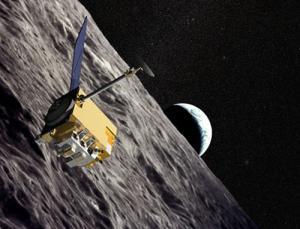
If the moon's poles hold water ice - a precious resource for future lunar explorers - orbiting spacecraft could spot it by bouncing radio waves off an upper layer of rock and ice. Catching the reflections with a second orbiter would produce a particularly clear signal if the ice is there, because ice reflections look much different from rock when viewed at an angle.
That's why researchers moved India's Chandrayaan-1 and NASA's Lunar Reconnaissance Orbiter (LRO) to within a few dozen kilometres of each other on 20 August.
Each spacecraft made it to its planned position, but programming problems on the US Mini-SAR instrument aboard Chandrayaan-1 prevented the device from sending a radio pulse, says Jason Crusan of NASA headquarters in Washington, DC.
Wrong direction
Later analysis showed that even if Mini-SAR had released the pulse, the signal would not have reached its target because Chandrayaan-1's orientation was drifting more rapidly than anticipated, Crusan said. Chandrayaan-1 has been orienting itself using spinning gyroscopes and the sun since its star-tracking system failed earlier this year.
To fix the problem, the team found a way to correct Mini-SAR's programming and better estimate Chandrayaan-1's drift. But then ground controllers abruptly lost radio contact with Chandrayaan-1 on 28 August - a death knell for the mission.
"We were actually in the middle of planning to conduct the experiment at a future time," Crusan told New Scientist. "Obviously with the termination of the Chandrayaan mission, that will not happen."
Solo missions
Stewart Nozette of the Lunar and Planetary Institute in Houston, Texas, who leads work on Mini-SAR's sister instrument on LRO, called Mini-RF, says the joint experiment would have produced a very clear signal of water ice if it were present.
"I think that it would have been the icing on the cake if we had been able to do that," Nozette told New Scientist. "It would have been the best thing you can do from the remote sensing perspective."
Even so, the radar measurements collected by LRO and Chandrayaan-1 individually could still reveal water ice - albeit not as clearly, Nozette says. Water ice should appear brighter than rock when viewed from above. If such a signal appears only in areas that are permanently shaded - where water ice would be protected from the warmth of the sun's rays, that could suggest the presence of water.
It may not be long before new information on the ice question is revealed. Chandrayaan-1 flew over "a lot of little craters that looked like they had ice" and mapped 95 per cent of the polar regions before its mission ended, Nozette says. The radar results are currently in review.



Do you honestly think the PTB are spending all of this money in search of water? Give me a break...